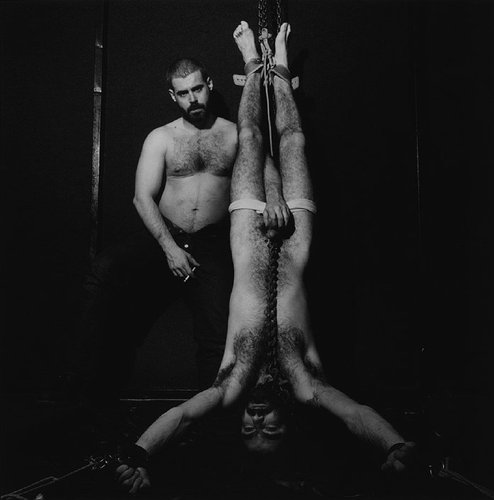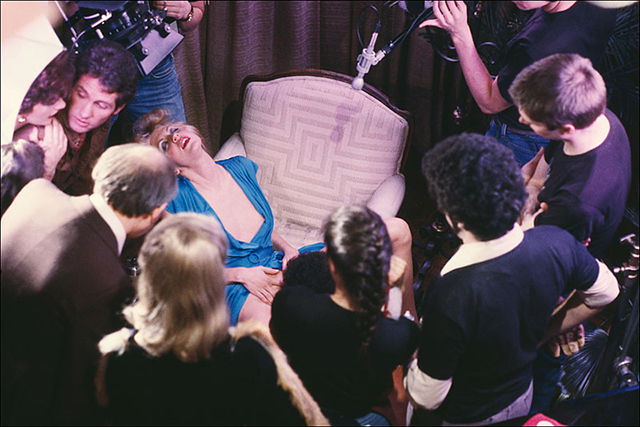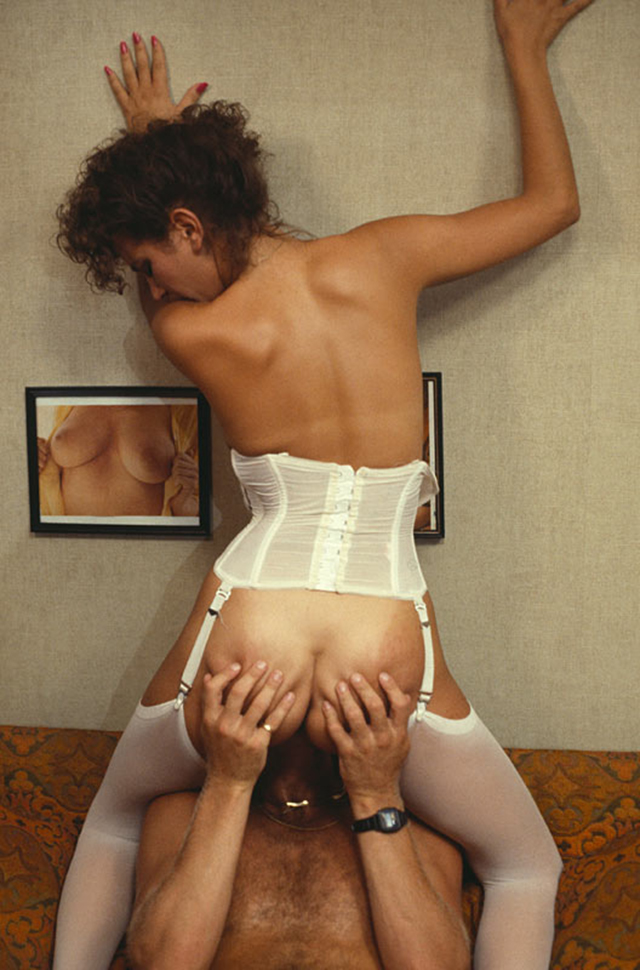Eight months ago, Karley Sciortino, host of Slutever and resident sex expert, interviewed photographer Barbara Nitke about her new book, American Ecstasy, then in its beginning stages, which features writings and photographs from Barbara's travels within the porn industry. We are happy to say that the book is now finished and printed. It's sexy and beautiful. Barbara was kind enough to share some of the photos and the forward to the book, never before published on the internet, written by influential critical thinker, Arthur Danto.
Advertisement
Some time early in the millennium, I agreed to serve as an “expert witness” in Barbara Nitke’s courageous suit against whichever Attorney General of the United States was in office. She was challenging the 1996 Communications Decency Act (CDA), which she held was unconstitutional. At roughly the same time I discovered her as an artist of singular merit. In fact her photographs would, at the time, have been my paradigms of images that might, but should not, have called down the full force of the CDA.My interest in Nitke’s art was in some measure based on that of Robert Mapplethorpe, whose retrospective at the Whitney Museum of American Art I had reviewed in The Nation, and on whom I was writing a book, the title of which was an expression of his, Playing with the Edge. The “edge” was the meeting of pornography and beauty, which defined his aesthetic, even at times in his photographs of flowers. Both Nitke and Mapplethorpe took photographs of couples in sadomasochistic interaction. Nitke speaks of her images as “romantic sadomasochism,” for her they are a deep expression of love. It is difficult to speak of Mapplethorpe’s images as showing love or, for the matter, romance. But I thought that there was a common threat in the two photographers where fear is mitigated by trust. They are, in a significant body of their work, SM artists. In 2003, Nitke’s romantic SM pictures were published in black-and-white in a book entitled Kiss of Fire.
Advertisement

Robert Mapplethorpe, Dominick and Elliot, 1979There is no love between Dominick and Eliot 1979, a famous photograph of Mapplethorpe’s, in which one man is hung upside down next to another, standing right side up, holding a cigarette—but the man holding the cigarette will desist or the game is over. He gets his pleasure on condition that he play the game, even if it would be difficult to see the game as motivated by love.In an afterword to her memories of early days, Nitke stayed in New York, finding jobs here and there. “From there,” she writes, “I found my way into the BDSM world, and shot sadomasochistic couples privately for a dozen years.” She explains to the reader that, “Eventually I realized that what fascinated me most was the genuine love I saw all around me. These were ordinary people who had extraordinary sex lives. Yet all they wanted was the same things everyone wants—to meet the love of their life and live happily ever after.” In an interview in Salon, Nitke answers a question about the romantic form of SM by saying, “They’re not doing anything but expressing love. I think if anything they are so careful about being safe. They negotiate everything up front to make sure that no one is being hurt in any way that they haven’t wanted to be hurt. I admire them as a community how they’ve managed to do edgy sexual things in a really good way.”I have mentioned Kiss of Fire to explain my admiration of her gifts. In most of the Kiss of Fire images, she has managed to invest the image with the love that she believes explains the action of the couple. One confirms her insight by looking at the faces rather than the bodies.
Advertisement
What Nitke has recorded in her new memoir, American Ecstasy, are scenes from the New York pornographic film industry of the 1980s. Hired by various cinematic porn producers, she was able, because of her photographic skills, to take stills of handsome men and women engaged in the kind of interactions sought out by amateurs, to use the French term, of erotic interchange.Though Nitke’s lawsuit challenged the CDA regarding her BDSM work, in fact there is an internal relationship between the lawsuit and the 1980s films. Barbara was married to a man considerably older than herself, who had a string of upstate theaters where people came to see films like Deep Throat and The Devil in Miss Jones. He made enough money to make it worthwhile, but he also, as Nitke relates in the introduction to American Ecstasy, “spent a fortune on legal fees fighting various obscenity charges the government brought against him. Losing even one of those cases would have bankrupted him and landed him in prison for years.” Her husband was Herb Nitke, and the book, but also and especially her lawsuit, are a gift to him.

In American Ecstasy, Nitke paints a rich picture of the working life of the sex stars. The first image is a mirror shot, in which she shoots herself taking a picture of a comical tangle of legs and arms, with no heads to speak of.Describing another moment on set, Nitke says, “somewhere in the slap happy middle of the night I’d look over and see a couple of naked girls huddled up together, their eyes glazed over with thousand-yard stares. That was the shot that I’d take for my private collection. And it was the power to capture that fleeting glimpse into someone’s soul, and preserve it forever, which convinced me I had to be a photographer.”
Advertisement
It could also convince her to be a writer. Her text is filled with funny, wry descriptions.“Around midnight we’d find ourselves packed like sardines in a slimy men’s room, overwhelmed by the smells, the exhaustion, and above all the sheer lack of sleep. The last scene of the day would always be one where the guy couldn’t produce the money shot. I’d glance around the crew and we’d nod to each other, knowing that it would be hours before the day’s end and those magical words, ‘That’s a wrap.’”The smells, the heat, the weariness—and the problems of getting the body to perform—defeat the glamor that brings young and attractive actors into the industry, not to mention the CDA and the crowds of censors that comb the internet.From reading these verbal “shots” of life in the porn world, one realizes that the scenario is as rigid as those of commedia dell’arte. Instead of Columbine and Pierrot, one has the needful housewife and the pizza boy, delivering initially the pie, and then himself. They strip and the female climaxes the scene of pleasure with fellatio. “It’s a wrap,” when the Pizza boy comes, withdrawing to cover her face with his ejaculation. But what if he can’t? Early in the book, Nitke uses the confession of one of the male actors, R. Bolla, writing about erection and ejaculation.“An erection is an emotional state. You can’t just will yourself to have one. It’s the autonomous nervous system like emotions are. So if you sit there and worry about getting erections… I thought what can I do to have one?”
Advertisement

The photograph that Nitke places next to Bolla’s soliloquy is a scene, which I take to be his thought. The woman is seen from behind, wearing a white garter belt holding up white stockings. Her bare breasts are reflected in one of the mirrors, as in Velasquez’s Las Meninas. The male is sitting beneath her, presumably administering oral sex. I take it as an illustration of “What can I do to have an erection?” Nitke’s trick is beginning to work. It is really a masterpiece.There is a section of Saint Augustine’s The City of God in which he writes that it is our fallen condition that only with passion can we consummate the sexual act. In the Garden of Eden, Augustine speculates that one can make love without passion. Adam planted his seed as passionlessly as we plant seed by throwing them into the Earth What would we need passion for if we were sowing corn?Alas, Nitke’s suit did not establish the unconstitutionality of the CDA. I was a poor expert. But I learned a lot about life and love in poring over her beautiful photographs. And reading her salty prose.Arthur Danto is the long-time art critic for The Nation and an influential thinker on philosophy, art theory, and aesthetics, whose writings have greatly illuminated the art world and beyond. Barbara Nitke is a New York-based photographer and professor at the School of Visual Arts. Her new (and highly recommended) book was just released and can be purchased here.
Advertisement
